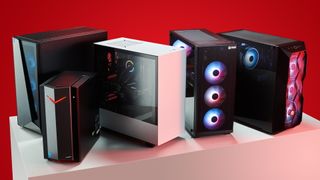SpaceX's Starship 'chopstick landing' technique just made every Kerbal Space Program enthusiast go green with envy
I had enough trouble making rockets go up up up, never mind down down down.
Kerbal Space Program is one of those games where, if you caught the bug, it never really left you. I still sometimes fall asleep at night envisioning new and creative ways to build rockets that fail miserably, despite not having touched the game for well over a year now.
Watching the latest SpaceX Starship booster return footage though, I felt that familiar itch return again (via BBC News). Elon Musk's pet space project has achieved many remarkable feats in the past few years, but manoeuvring a Super Heavy rocket booster down to a launch pad under its own power, turning upright on its end, and then catching it with a pair of chopsticks in mid-air in a perfect display of tech ballet really strikes as a breakthrough moment for spaceflight.
What makes this even more impressive? It was the first proper attempt at this rocket booster capture method and one that SpaceX's engineers thought was something of a long shot. After all, the company has taken the tech industry approach of "move fast, break stuff" to something of an extreme in previous attempts to both launch and land its rocket boosters, and this new 'mid-air catch' method looked like its most ambitious version to date.
That's compounded by the fact that, a mere 18 months ago, Starship's inaugural flight ended in, well, an explosion. Now here it is (or at least a part of it, anyway), gently boosting itself back down to Earth like physics is no big deal.
Just two minutes before landing, final checks were still being made to determine whether the attempt was possible, or whether it was better to bail out and dump the booster in the Gulf of Mexico.
Still, the call was made, and the audible cheers from the SpaceX team and observers are enough to send a genuine shiver down the spine as the booster first slows its descent, then manoeuvres itself gently into position, before being clamped into place.
As for the ship section (which eventually, Musk and his engineers hope will take a crew to the Moon, Mars, and potentially beyond), that too made something of a successful "landing" in the Indian Ocean roughly 40 minutes later.
The biggest gaming news, reviews and hardware deals
Keep up to date with the most important stories and the best deals, as picked by the PC Gamer team.
This beats all of my KSP attempts by some margin, almost all of which have ended in hilarious disaster. YouTuber Scott Manley has been experimenting with similar launch and return rocket-catching methods, although even they have to admit that the footage of a clean catch was the result of reversing a launch video from a chopstick-style tower.

Best gaming PC: The top pre-built machines.
Best gaming laptop: Great devices for mobile gaming.
So, hats off to the SpaceX team for managing the extremely difficult on the first attempt. Just as well really, as NASA is hoping the the Starship mega-rocket will launch the moon lander for its Artemis 3 mission, scheduled for 2026.
While I imagine NASA will be more concerned with delivering its equipment to the Moon safely rather than successfully recovering the booster for re-use, this latest demonstration appears to show that SpaceX's technology is developing at pace.
A first-test demonstration of the new landing method is one thing, but plenty more tests will have to occur before the Starship system is trusted to carry extremely expensive equipment or actual human beings. Still, if things continue at this rate, it looks like future astronauts might be making use of a rocket system with a party trick—and one that Kerbal Space Program enthusiasts will continue to look at with envy and awe.

Andy built his first gaming PC at the tender age of 12, when IDE cables were a thing and high resolution wasn't. After spending over 15 years in the production industry overseeing a variety of live and recorded projects, he started writing his own PC hardware blog in the hope that people might send him things. And they did! Now working as a hardware writer for PC Gamer, Andy's been jumping around the world attending product launches and trade shows, all the while reviewing every bit of PC hardware he can get his hands on. You name it, if it's interesting hardware he'll write words about it, with opinions and everything.
Most Popular







